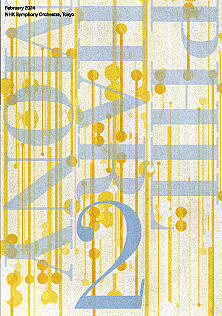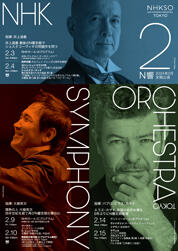- Home
- Concerts
- Subscription Concerts 2023-2024
- Program A
- No. 2004 Subscription (Program A)
No. 2004 Subscription (Program A)
NHK Hall
Google Map Seating Chart
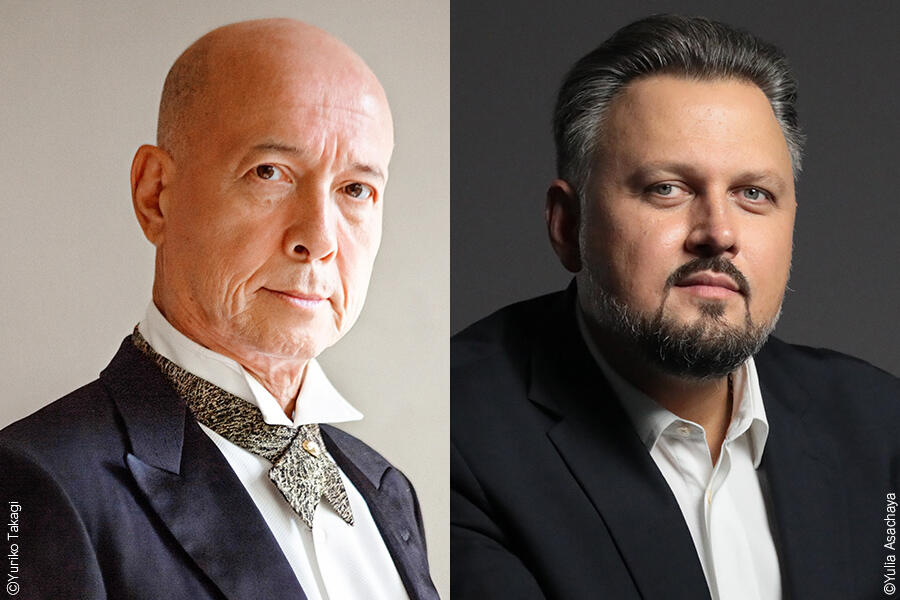
Important Announcement
Program
Johann Strauss II / Im Krapfenwald’I, polka française Op. 336 (In Krapfen’s Woods)
Along with his father (1804–1849) of the same name, Johann Strauss II represents the famous Austrian musical family which founded the basis of the Viennese waltz and led it to its heyday. Known today as “The Waltz King,” Strauss II went into music despite his father’s opposition to be a successful composer, conductor and violinist. The Younger wrote around 170 waltzes of great refinement including An der schönen blauen Donau (The Blue Danube) (1867) besides over fifteen operettas of which the best known is Die Fledermaus (The Flittermouse)(1874).
Strauss II left us approximately 120 polkas, too. This duple-meter dance of Bohemian origin was introduced to Vienna in the late 1830s before becoming a popular ballroom dance around Europe. Op. 336 performed today is a fine example of a “polka française” (French polka) which is elegant in character and slower in tempo in contrast to “polka schnell” (quick polka). Op. 336 is pleasantly naturalistic with whistles evocating the twitter of cuckoos and other birds.
The fact that Op. 336 was first performed in 1869 in Russia as Im Pawlowsk Walde (In the Pavlovsk Woods) is not irrelevant to the rest of today’s program. Nearly every year from 1856 to 1869, Strauss II was invited by a Russian railway company to stay in the summer retreat Pavlovsk (near St. Petersburg) to conduct the summer concert season. For the audience of his birthplace, the composer later renamed it In Krapfen’s Woods after an area of the Vienna Woods.
[Kumiko Nishi]
Shostakovich / Suite for Variety Orchestra No. 1 —March, Lyrical Waltz, Little Polka, Waltz II
The St. Petersburg-born composer Shostakovich is deemed to be a preeminent symphonist with his fifteen tours de force, not forgetting being an important contributor to chamber music. Theatrical music (operas, ballets, film scores and incidental music works), however, occupies quite a wide space in his oeuvre. Having lost his father, the teenage composer started to gain his bread as a silent-movie pianist in 1924. Even after the well-received premieres in 1926–1927 of his first two symphonies, he, still in need, penned a number of theatrical works. This continued over his entire life to bring about, for instance, as many as thirty-five film scores total.
The Suite for Variety Orchestra No. 1 consists of eight delectable gems picked from Shostakovich’s film and stage scores. Assembled by an anonymous person (or possibly by Shostakovich himself) around the mid-1950s, this set had been erroneously identified with the Jazz Suite No. 2 until recent years. As the correct title hints, the orchestral formation including a guitar, an accordion and saxophones sticks out of the classical frame. After jaunty March from the 1941 Soviet movie The Adventures of Korzinkina, Lyrical Waltz gives an impressive accordion solo in the central section. Probably the composer’s most popular piece today, Waltz II is heard in the Soviet movie The First Echelon (1956) and Stanley Kubrick’s last film Eyes Wide Shut (1999): the haunting melody first-sung by a saxophone will be roared by a trombone towards the end to bolster the melancholic feeling up.
[Kumiko Nishi]
Shostakovich / Symphony No. 13 B-flat Minor Op. 113, Babi Yar*
All the fifteen symphonies Shostakovich left us were more or less at the mercy of the time. Interestingly enough, No. 8 (1943) and No. 9 (1945) which incurred the Soviet authorities’ wrath the most among all his symphonies are purely instrumental. Even No. 5 (1937), No. 11 The Year 1905 (1957) and No. 12 The Year 1917 (1961) understood by the government to “rehabilitate” the composer, do not have any sung-words.
No. 13 (1962) is Shostakovich’s first vocal symphony since propagandistic No. 2 (1927) and No. 3 (1929) both requiring a chorus at the close. Moreover, No. 13, a choral symphony for an exceptional formation (bass soloist, bass chorus and orchestra), is virtually sung throughout like Mahler’s No. 8.
Although a product of the post-Stalin era, namely from the Thaw period, No. 13 was nevertheless a highly risky work because of the politically provocative texts by the young Soviet poet Yevgeny Yevtushenko (1933–2017). The poem Babi Yar used for the first movement, above all, denounces the anti-Semitism still found everywhere, a taboo subject for the USSR. (Babi Yar is a ravine located on the outskirts of Kyiv, Ukraine where the Nazis massacred Jews in 1941.) The symphony vexed Nikita Khrushchev and his henchmen who attempted to sabotage the 1962 premiere in Moscow.
The tense first movement is haunted by ill-omened bell tolls. The chorus enters singing “There is no monument over Babi Yar. / The steep ravine is like a coarse tombstone.” The second movement Humor is a polka-style scherzo mocking at “Czars, kings, emperors, / potentates of the whole earth” as they “were unable to command humor.” The following three movements are performed seamlessly: In the Store describes Soviet women patiently standing in a queue in the severe cold, while Fears, opened by a tam-tam (gong) clanging, decries “new fears” replacing fears of bygone (Stalinist) days. Waltz-style A Career praises Galileo Galilei for having been brave enough to turn his back to the earthly success in life, before whispering the symphony’s conclusion with a bell tolling.
[Kumiko Nishi]
Artists
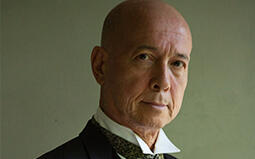 ConductorMichiyoshi Inoue
ConductorMichiyoshi Inoue
Michiyoshi Inoue, a renowned conductor born in 1946, announced his coming retirement at the end of 2024. What he chose when he was invited to the NHK Symphony Orchestra’s subscription concerts in November 2016, after an interval of 38 years, was an all-Shostakovich program. And it was in October 2019 when he caused a sensation performing a program of Philip Glass and Shostakovich. In December 2020 under the pandemic, he conducted Shostakovich Symphony No.1, followed by his successful appearance with the composer’s Symphony No.10 in the November 2022 subscription concerts. And on this occasion, in the February 2024 subscription concerts, he goes on with Suite for Variety Orchestra No. 1 and Symphony No. 13 Babi Yar.
Michiyoshi Inoue was born and raised after the Second World War, when the world was dominated by the Cold War between East and West, and has roots in both Japan and the United States. He overlaps himself with Shostakovich, an artist who struggled but managed to survive the socialist system of the former Soviet Union. Therefore his unabashed devotion to the composer which is expressed in his openly declared words of “Shostakovich is myself” has permeated each and every member of the NHK Symphony Orchestra, achieving performances with an extremely high level of empathy.
Im Krapfenwald’l, polka française (In Krapfen’s Woods) by the waltz king Johann Strauss II, which is placed at the beginning of today’s program, stands out. I assume Inoue has selected this work as it was written during the composer’s stay in Pavlovsk at the invitation of the Russian Empire, and it was originally titled Im Pawlowsk Walde (In the Pavlovsk Woods). But it may also be related to the fact that the 3rd piece of Shostakovich’s Suite for Variety Orchestra No. 1 to be performed on this occasion is Little Polka. Inoue’s brilliant conducting style, which suggests that he aspired to be a dancer in his youth, is also something to pay attention to.
[Takuo Ikeda, music journalist]
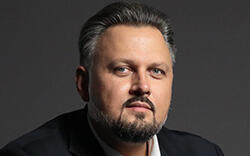 BassAlexey Tikhomirov*
BassAlexey Tikhomirov*
Bass singer Alexei Tikhomirov, a native of Kazan, the capital of the Russian Republic of Tatarstan, became a soloist with Moscow’s Helikon Opera in 2005, and has since continuously appeared at major European opera houses such as the Bolshoi Theatre, the Staatsoper Berlin, and the Staatsoper Hamburg. He has a wide-ranging repertoire, not to mention that of Russian operas, including the title role of Boris Godunov and Boris in Lady Macbeth of Mtsensk, but also Fasolt in Das Rheingold and Basilio in The Barber of Seville. He first appeared in Japan in October 2019 singing the role of Duke Gremin in Eugene Onegin at the New National Theatre, and showed a great presence with his deep and soft singing voice.
He has sung in Shostakovich’s Symphony No. 13 Babi Yar with the Chicago Symphony Orchestra under Muti in September 2018, and then in September 2023, with the musicAeterna and the SWR Symphonieorchester under the baton of Teodor Currentzis and has won artistic acclaim. So our expectations are certainly high to imagine what sort of world he will portray with the NHK Symphony Orchestra, in his first appearance.
[Naoko Murota, music critic]
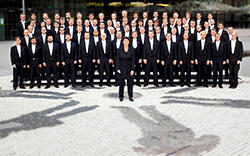 Male chorusOrphei Drängar*
Male chorusOrphei Drängar*
The Orphei Drängar Male Choir, known as the servants of Orpheus, was founded in 1853 in Uppsala, 70 kilometers north of the Swedish capital Stockholm. It is believed to have started when students of Uppsala University, the oldest university in Northern Europe, sang choir works to cheer up the town of Uppsala, which had become isolated due to an epidemic.
The choir worked under the guidance of Alfvén, Sweden’s leading composer, and Eric Ericson, praised as the “King of Chorus,” who served as conductors, and especially the relationship with Ericson continued for forty years from 1951 through to 1991, during which time, the choir’s ability has improved dramatically to the point where it is said to be the world’s best a cappella choir. From 2008, Cecilia Rydinger has been the conductor. The finely honed harmonies of about 90 male voices overwhelmingly move the hearts of those who listen to the music. Because they have a wide repertoire ranging from Renaissance polyphony to contemporary music, the work by Shostakovich they will sing on this occasion will surely display the underlying strength of such choruses.
[Naoko Murota, music critic]
* Artists have been changed from initially scheduled Evgeny Stavinsky (Bass).
Download
Ticket
Program A
No. 2004 Subscription (Program A)
NHK Hall
Google Map
Seating Chart
Single Tickets Release Date
Pre-sales for Subscribers:Thursday, October 26, 2023
*about subscribers
Sale to General Public:Sunday, October 29, 2023
Price
| S | A | B | C | D | E | |
|---|---|---|---|---|---|---|
| Ordinary Ticket | 9,800 | 8,400 | 6,700 | 5,400 | 4,400 | 2,800 |
| Youth Ticket | 4,500 | 4,000 | 3,300 | 2,500 | 1,800 | 1,400 |
Seating chart Enlarge Print PDF
*tax included
*Subscribers receive a 10% discount (Available at NHKSO WEB Ticket and N-Kyo Guide)
*For wheelchair-accessible seats, please refer to the N-Kyo Guide
Youth Tickets
Youth Tickets are great options for those of 25 years old and younger
Subscription tickets
Release Date
ANNUAL SUBSCRIPTION TICKETS
Mon., July 17, 2023 10:00am
[For Subscribers: Sun., July 9, 2023 10:00am]
SEASONAL SUBSCRIPTION TICKETS (WINTER)
Tue., Oct. 17, 2023 10:00am
[For Subscribers: Thu., Oct. 12, 2023 10:00am]
Where to buy
NHKSO WEB Ticket | Saturday, February 3 (In English / Seats not selectable)
NHKSO WEB Ticket | Sunday, February 4 (In English / Seats not selectable)
NHKSO WEB Ticket (In Japanese only / Seats selectable)
N-Kyo Guide (Purchase by telephone only)
Other Ticket Agents
Broadcast
 NHK-FMNo. 2004 Subscription (Program A)
NHK-FMNo. 2004 Subscription (Program A)
Thursday, Feb 8, 2024 7:30PM - 9:10PM
Program:
Johann Strauss II / Im Krapfenwald’I, polka française Op. 336 (In Krapfen’s Woods)
Shostakovich / Suite for Variety Orchestra No. 1 —March, Lyrical Waltz, Little Polka, Waltz II
Shostakovich / Symphony No. 13 B-flat Minor Op. 113, Babi Yar*
Conductor:Michiyoshi Inoue
Bass:Alexey Tikhomirov*
Male chorus:Orphei Drängar*
Recorded:February 3, 2024 NHK Hall
*Repertoire, conductor, soloists and program order are subject to change without notice.
*Pre-school children are not allowed in the concert hall

